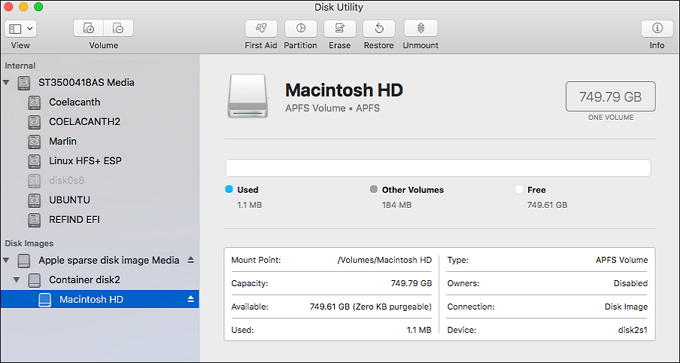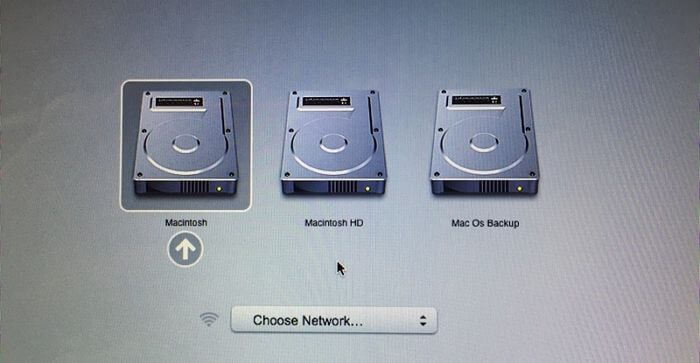You may face the situation of no Macintosh HD in Disk Utility on your MacBook Pro/Air. Macintosh HD is the name of the internal hard drive of a Mac running macOS 10.15 or later; you may find Macintosh HD in Disk Utility.
If you can't find Macintosh HD in Finder or Recover Mode and are looking for a solution, congratulations in advance! This article will introduce 5 effective and feasible solutions.
Why Is Macintosh HD Not Showing Up in Finder
The leading causes why Macintosh HD does not show up in Finder or Recovery Mode are as follows:
- 📁Corrupted File System: the damaged file system of the Macintosh HD can make Macintosh HD not mounted in Mac Finder, so it is not showing up in Finder or Recovery Mode.
- 🖇️Connector Corruption: The Macintosh HD cable to your Mac is damaged and non-functional, or an error like "com.apple.DiskManagement.disenter error" prevents it from mounting on your Mac, so you can't find the internal hard drive in Finder.
- 💾Hard Drive Failure: if the hard drive is physically damaged due to head or component failure, the Mac startup disk will not appear in Finder/Recovery Mode.
- ⚠️Virus Attacks: if your Mac is attacked by a virus or malware, causing data loss and corruption, internal hard drives are not mounting on your Mac.

Preparation: Recovery Data from Macintosh HD
If your Macintosh HD stores many important files you need, but they can't be displayed in the Finder or Recovery Mode now without a specific reason, it could be a virus attack or damage to the hard drive's file system.
In this case, it is recommended that you recover data from Macintosh HD first and then repair the Macintosh HD that is not showing in the Finder/Recovery Mode issue.
Therefore, the only thing you need to do before resolving the issue of not showing is to find a professional data recovery tool. EaseUS Data Recovery Wizard for Mac is a trusted and powerful software that supports data recovery of numerous file types on different devices.
With EaseUS Data Recovery Wizard for Mac, you can recover data on the not-showing Macintosh HD with a few clicks quickly and effectively. It can fix common unmounting errors. Follow the steps here:
Step 1. Select the drive to be scanned
In the main EaseUS Data Recovery Wizard window, there will be a list of the drives connected to your Mac. Select the drive you need to recover lost/deleted files from, and click the "Search for lost files" button.

Step 2. Select your lost data/files
EaseUS Data Recovery Wizard for Mac will immediately scan your selected disk volume and display the scanning results on the left pane. You can sort the results to find the wanted files if you are looking for certain files.

Step 3. Recover lost/deleted data
Once you have found the desired files, preview the files and then click "Recover" to begin the recovery of your deleted/lost Mac files.

Note saving the data to a secure location instead of the Macintosh HD, and you can fix the disk0s2 not mounted in Disk Utility problem referring to the next part.
Share this article on social media to help others learn how to recover data from not showing Macintosh HD.
Quick Solutions: Macintosh HD Not Showing Up in Recovery Mode
Even many computer novices know one thing: restarting a computer can often resolve most computer glitches in their daily work and life. The easiest way to resolve the issue when Macintosh HD is not displaying properly is to restart your Mac by holding down the power button until it turns off.
After a few minutes, your Mac may return to normal when you turn it on. If rebooting Mac doesn't solve this problem, don't worry; it's just a panacea, and we can use the following practical solutions.
| This solution can fix the no Macintosh HD in Disk Utility quickly, and you don't worry about losing data in the process. | |
| Rebooting your Mac in Safe Mode can resolve typical issues on your Mac, but it will take some time to run programs in Safe Mode. | |
| When using Terminal, ensure the command is correct. Different commands will produce different utilities, which may cause data loss. | |
| Using commands is unsuitable for computer novices, and if you are concerned about irreparable data loss due to errors, you are advised to use a simpler method. | |
| Reinstalling macOS will erase your Macintosh HD, permanently deleting all data. Consider it as the last option if other solutions cannot resolve the problem. |
Repair Internal Hard Drive Not Showing Up in Finder
In this solution, you should start Mac in Recovery Mode. Follow the steps below:
Step 1. Press "Command + R" to boot your Mac in Recovery Mode, and release them once the Apple logo appears.
Step 2. Select "Disk Utility" from the four options in the macOS Utilities window, and click "Continue".
Step 3. Select "Unmountable Macintosh HD" from the left menu and click "First Aid" to repair the disk errors of the Macintosh HD.
For Apple Silicon (M1/M2): Press and hold the power button until startup options appear, then click the gear icon labeled "Options".
EaseUS data recovery software offers Mac data recovery in macOS Recovery Mode. Read this article if you need to perform a data recovery.
Run Mac Data Recovery in Recovery Mode [Without Creating USB Drive]
This post discusses how to run Mac data recovery in Recovery Mode when your Mac won't boot up. Read more >>
Reboot Mac in Safe Mode to Fix Macintosh HD Not Showing
Rebooting your Mac in Safe Mode will repair errors found in the process, which can help fix the Macintosh HD not showing errors. Follow the steps below:
Step 1. Shut down your Mac first, and press "Shift" to restart it in Mac Safe Mode.
Step 2. Use your computer generally once you've entered Safe Mode. For instance, if a certain app caused your Mac to crash, try rerunning the app in the Mac Safe Mode to see if the problem still exists.

Use Terminal to Fix Macintosh HD Not Showing in Disk Utility
This solution can be considered a different choice from the first one, which you still need to perform in Recovery Mode first. Refer to the following:
Step 1. Boot your Mac in Recovery Mode, and choose "Terminal" from the Utilities list.
Step 2. Type diskutil list to list available volumes.
Step 3. Check the Volume identifier.
Step 4. Enter diskutil repairvolume/disk#. Replace # with Macintosh HD's volume idertifier.
Fix Macintosh HD Not Showing with FSCK Command
To fix the Macintosh HD not showing in Finder or Recovery Mode issue, you should ensure your Mac is in the shutdown state. And then follow the steps here:
Step 1. Restart your Mac by holding "Command + S", and release the keys once you see the Apple logo.
Step 2. Type the command: /sbin/fsck –fy, and press "Enter" to continue.
Step 3. Retype the above command when you see the "File system was modified" message.

Step 4. Reboot your Mac when you see the message "The volume Macintosh appears to be OK".

Reinstall macOS to Fix Macintosh HD Not Showing Up Issue
Factory resetting the MacBook is the last option to consider because this can cause data loss, and recovering data is a very troublesome task unless you use the EaseUS data recovery Mac.
Note that the Macintosh HD will be formatted and reinstalled macOS on your Mac, so before you start with the factory reset, make sure you have a backup. And then you can follow the steps below:
Step 1. Boot your Mac into Recovery Mode by holding "Command + R", and release the keys once you see the Apple logo.
Step 2. Go to "macOS Utilities > Disk Utility" and select "Mount Macintosh HD".
Step 3. Click "Erase", select "Reinstall macOS", and click "Continue".
Conclusion
You can fix the no Macintosh HD in Disk Utility with the 5 practical methods: repairing in Recovery Mode, rebooting Mac in Safe Mode, using Mac Terminal, using FSCK command, and reinstalling macOS.
And suppose you want to recover data from the non-existent Macintosh HD. Final Note: If your data is critical and the drive is not detected, avoid further attempts that could cause permanent damage. Professional data recovery services may be needed.
no Macintosh HD in Disk Utility FAQs
Here are some questions people also ask when they search for how to fix no Macintosh HD in Disk Utility:
1. Can I hide my Macintosh HD on my MacBook Pro?
Yes. Follow the steps to hide Macintosh HD from your MacBook Pro:
Step 1. Select "Finder" in the Preferences.
Step 2. Click on "General".
Step 3. Disable the Hard drives option by clicking on it
When you start up your MacBook Pro, MacBook Air, or other models, the Macintosh HD symbol will no longer appear on your desktop.
2. What happens if I erase Macintosh HD in Disk Utility?
Erasing your Macintosh HD will delete data on it permanently, and you can't restore it from Trash. Still, you can use third-party data recovery software to get it back.
3. Why can't I get my Macintosh HD in Recovery Mode?
The following reasons can cause the Macintosh HD to disappear in Recovery Mode:
- Your Mac hard drive is either dead or not properly connected.
- Running an old version of macOS that does not have a recovery partition.
- The damaged file system of the Macintosh HD.
- The Macintosh HD cable to your Mac is damaged or non-functional.
- The hard drive is physically damaged.
- A virus or malware attacks your Mac.
Was This Page Helpful?
Jaden is one of the editors of EaseUS, who focuses on topics concerning PCs and Mac data recovery. Jaden is committed to enhancing professional IT knowledge and writing abilities. She is always keen on new and intelligent products.
Brithny is a technology enthusiast, aiming to make readers' tech lives easy and enjoyable. She loves exploring new technologies and writing technical how-to tips. In her spare time, she loves sharing things about her game experience on Facebook or Twitter.
-
EaseUS Data Recovery Wizard is a powerful system recovery software, designed to enable you to recover files you’ve deleted accidentally, potentially lost to malware or an entire hard drive partition.
Read More -
EaseUS Data Recovery Wizard is the best we have seen. It's far from perfect, partly because today's advanced disk technology makes data-recovery more difficult than it was with the simpler technology of the past.
Read More -
EaseUS Data Recovery Wizard Pro has a reputation as one of the best data recovery software programs on the market. It comes with a selection of advanced features, including partition recovery, formatted drive restoration, and corrupted file repair.
Read More
Related Articles
-
What Is RAW Drive Recovery? How to Recover Data?
![author icon]() Jean/Dec 12, 2025
Jean/Dec 12, 2025 -
Recover Deleted Files Mac Without Time Machine
![author icon]() Dany/Dec 12, 2025
Dany/Dec 12, 2025 -
How to Recover Data from Crashed Hard Drive Mac
![author icon]() Dany/Dec 14, 2025
Dany/Dec 14, 2025 -
Recover Data from Iomega Hard Drive [Simple Guide]
![author icon]() Dany/Dec 12, 2025
Dany/Dec 12, 2025
